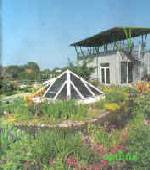Bamboo is good for environment now and the future
Bamboo has enormous potential for alleviating many problems - both
environmental and social - facing the world today. The increasing rate of
tropical deforestation makes the search for alternative natural resources
important. The characteristics of bamboo make it a perfect solution for the
environmental and social consequences of tropical deforestation.
Its biological characteristics make it a perfect tool for preventing soil
erosion (Austin et al. 1970) and reducing carbon dioxide levels in the
atmosphere. Additionally, its qualities of strength, light weight and
flexibility make it a viable alternative to tropical timbers that typically
supply the furniture and building materials industries. Lastly, bamboo has
rapid growth capabilities enabling it to reach maturity within three to five
years. Therefore, bamboo is an ideal economic investment that can be utilized
in many different manners.
ENVIRONMENTAL SOLUTIONS - SOIL EROSION
Because of the extensive rhizome system that
lies primarily in the top foot of soil, bamboo works well to prevent soil
erosion occurring in flood plains, along riverbanks and on steep hillsides. It
can control landslides, keep flooded rivers along their natural course and
slow the speed of the water flow (Austin et al. 1970).
CARBON DIOXIDE BUILDUP
According to the Environmental Bamboo
Foundation (EBF), bamboo’s growth habits allow it to produce more oxygen than
equivalent stands of trees. This aspect holds significant implications for the
reduction of atmospheric carbon dioxide - the greenhouse gas and a major
environmental issue today - as planting and replanting of bamboo in groves
and plantations could help mitigate- this problem.
TROPICAL TIMBER DEPLETION
Harvesting of bamboo is frequent since it
reaches maturity within 3-4 years, and new shoots appear regularly and in
great numbers. Replenishment and regrowth are quite fast and efficient in
comparison to tropical timber trees, which have life cycles that are two to
ten times longer. Bamboo increases its biomass by l0-30% per year which far
exceeds that of trees, which is 2-5% annually, according to EBF. Also,
bamboo produces more cellulosic material per acre than southern pine wood
(Austin et al. 1970). Evidently, bamboo is a more sustainable resource than
tropical timber trees and hence, it could realistically replace or supplement
tropical trees in many industries that are facing raw material shortages.
DEVELOPMENT SOLUTIONS
TENSILE STRENGTH
Studies in Puerto Rico have shown that the
species Bambusa tulda can withstand up to 52,000 pounds per square inch
(psi) before breaking (Farrelly 1984). In comparison, walnut wood takes 20,000
psi and steel for reinforced concrete withstands 60,000 psi. This makes bamboo
wood a potential alternative, at least in some applications, to steel which
requires more energy for processing. Its strength and flexibility also make it
a viable material for building shelters that offer protection against
hurricanes and earthquakes.
ECONOMICS
Because harvesting of bamboo can be quite
frequent, return on investment comes much quicker than investment in tropical
timber plantations. Therefore, bamboo community forestry projects are
economically more attractive, especially for small farmers with little
capital. There is a considerable potential for bamboo’s use in rural
development projects aimed at providing sustainable economic opportunities for
the poor. Its high yield capability makes it a good cash crop for income
generation, and thereby for improvement in the living standards, in rural
areas. Incorporating value-added manufacturing into bamboo community
forestry projects makes them even more advantageous to rural people, who
usually earn the least profit as mere suppliers of raw materials. As Farrelly
(1984) states: ".... .socially just forms of bamboo development will be an
important aspect for future designs for exploiting the plant."
In summation, bamboo’s excellent growth,
mechanical and engineering properties make it a fine alternative to tropical
timber. Unfortunately, bamboo is still dubbed the "poor man’s timber",
representing a social stigma (Willcox 1992). Perhaps this attitude towards
bamboo will change with the increased urgency of environmental issues and with
more dedicated attention to the poverty problem. More widespread education and
communication are needed, mobilizing people to support greater research on
solutions and alternatives to deforestation, proper implementation and
utilization of research results for the betterment of resource-poor people:
all with bamboo in a pivotal role.
Bamboo have been used to make bamboo Tiki bar,
bamboo fence,
bamboo furniture,
bamboo pole and building materials,
bamboo charcoal products and much
more.
![]() Gardeners' Corner
Kids'
Garden
Sustainable Garden
Contact Us
Gardeners' Corner
Kids'
Garden
Sustainable Garden
Contact Us![]()


